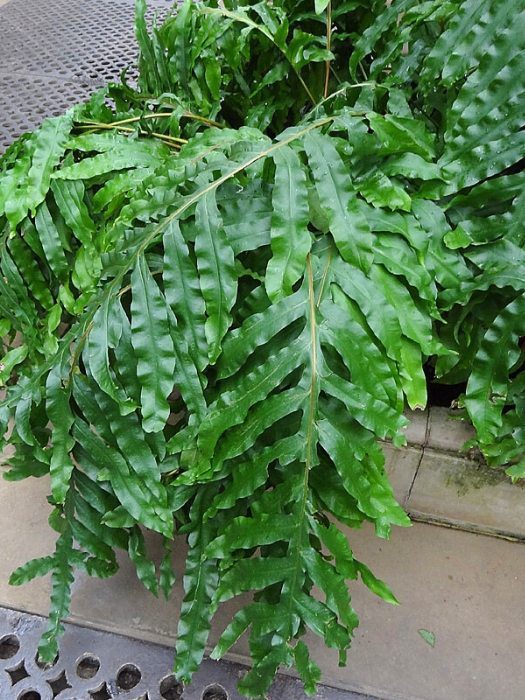The Creeping Golden Polypody (Phlebodium decumanum) is a lush and ornamental plant belonging to the Polypodiaceae family. Also known as the Mato Grosso Fern, it is native to various regions in Latin America, including the Brazilian Amazon. With its intense green foliage and a unique structure, this species captivates with its giant and elegant fronds and its adaptability to different growing conditions.
The Creeping Golden Polypody is a lithophyte (grows on rocks) or epiphyte, meaning it grows on other plants, typically on palms like the urucuri palm (Attalea phalerata), using them as support to reach greater exposure to light. Its stem is a long rhizome, approximately 4 cm in diameter, with long brown scales that give it a furry appearance.
This stem grows parallel to the substrate, taking on a creeping or climbing form and sends its roots to anchor and absorb water and nutrients from the surrounding environment. Its fronds, which can reach up to 1.4 meters in length, are pinnate, recurved, and semi-pendant, with smooth, wavy margins, and slender petioles. There is also a variety with curly fronds.

One characteristic of the Creeping Golden Polypody is the presence of small rust-colored powdery spots, known as sori, on the underside of the fronds. These sori contain sporangia, structures responsible for producing spores that will trigger the plant’s asexual reproduction. When released, these spores can germinate and give rise to new plants, allowing for successful dissemination and colonization in its natural habitat.
Due to its lush beauty and adaptability, the Creeping Golden Polypody is widely used in landscaping projects as an attractive option for shade gardens, winter gardens, and indoor spaces. It is one of the stars of the current Urban Jungle movement. Its pendant appearance and graceful foliage make it a popular choice for hanging pots and baskets, creating a green cascade effect that adds texture, charm, and exoticism to any space.

Moreover, this species can also be used as part of compositions in vertical gardens, bringing a sense of tropical nature and a serene atmosphere to urban environments. Its ability to grow on tree trunks or in assemblies with moss and substrates makes it a versatile and easy-to-handle choice for creating beautiful vertical structures in indoor and outdoor areas.
The Creeping Golden Polypody thrives in environments with partial shade to diffused light, avoiding direct exposure to intense sunlight during the hottest hours of the day. In its natural habitat, it is commonly found in humid forests, where it receives filtered light through the tree canopies. For cultivation in gardens and indoor environments, it is essential to replicate this type of lighting.
As for the soil, this fern prefers substrates rich in organic matter, slightly acidic, and with good water retention capacity. It is recommended to use a fibrous mixture of organic compost, composted pine bark, and sphagnum, ensuring a moist and well-drained environment for healthy root development. If you prefer ready-made mixtures, obtain substrates specifically designed for ferns.
Watering should be frequent, keeping the soil consistently moist but not waterlogged. The Creeping Golden Polypody is sensitive to drying out, so it is important to maintain the proper humidity. The use of saucers under the pots is a useful practice to ensure that the plant can retain excess water and maintain a suitable environment for its development.
This plant appreciates high air humidity, which can be achieved by regularly spraying water on the leaves or using a room humidifier, especially during drier periods or in air-conditioned environments. Another important point is to avoid drafts and very windy locations, as this can lead to dehydration of the fronds and leaf damage. Keeping the plant protected in a location with good air circulation but without strong winds will contribute to its health. It also does not tolerate intense cold or frost.
It propagates easily through the division of clumps or by using the spores present on the sori of the lower fronds. When opting for division, it is important to carefully remove the Creeping Golden Polypody from the pot and separate the naturally emerging seedlings at the edges of the clump. Then, replant each seedling in individual pots with the appropriate substrate and ensure they receive the proper water and light for their development.
Avoid dividing the rhizome too much. The larger the seedling, the greater the probability of successful development. For propagation using spores, it is necessary to collect the sori when they are mature, ensuring that the sporangia are releasing spores with a dark brown color. Then, the spores should be sown in a substrate mixture and kept in a humid environment, such as a humidity chamber, to create a suitable microclimate for germination.


